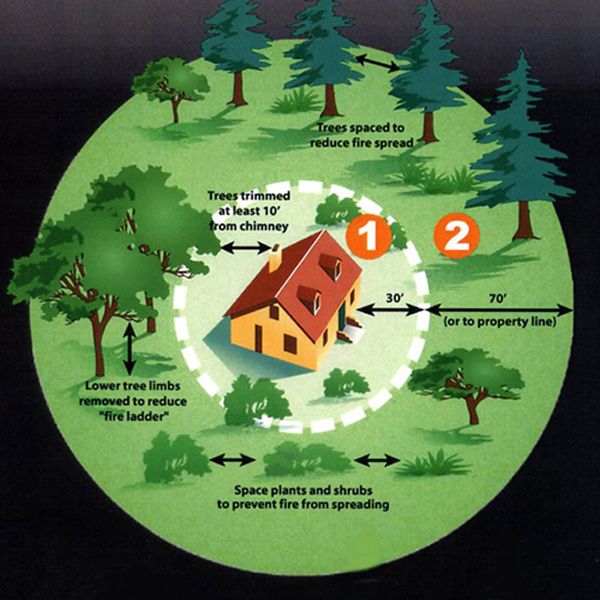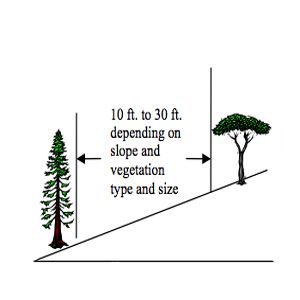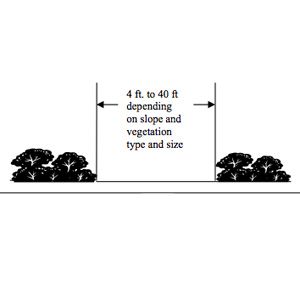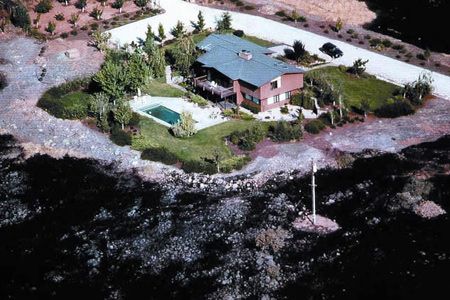In the wake of the relief effort after California’s recent wildfire devastation, a major component in fire-safe home rebuilding is “defensible space”—a specially planned and designed area around your home that provides maneuvering space for firefighters, serves as a barrier to impede raging wildfires from getting to your doorstep, and prevents house fires from spreading to the wild. In contrast to the traditionally lush American yard, a defensible space uses the judicious selection and placement of plantings as a strategy to decrease the spread of fires.
Since many homeowners neglect to incorporate defensible space into their landscaping—fire-safe designs have a reputation of diminishing curb appeal—California has initiated the Why 100 feet? campaign, complete with billboards lining the interstate. Effective January 2005, a 100-foot defensible space around homes, following a two-zone model, was required by California state law. Defensible space doesn’t have to be unsightly, though. In fact, a working knowledge of how defensible space can save your home, as well as an understanding of the right plants to use, may sway even the most fastidious of gardeners.
Zones
While California only requires a mandatory 100-foot defensible space in two zones, models can include up to four zones. Zone 1—the area closest to your home and any other structure on your property, like garages and guest houses—is the immediate perimeter, extending 30 feet out from the edge of the structure. Applying defensible design in this space, along with clear street signs and house numbers, will make it easy for fire-safety workers to get to you in an emergency. Zone 2 extends 70 feet past the end of Zone 1, completing the mandated defensible space area for California residents. However, if your property line lies beyond the 100-foot defensible space, you should also maintain any forested areas in Zones 3 and 4 of your property by trimming trees to keep them clear of each other and removing litter.

Defensible Design Principles
A common misconception is that defensible landscape design calls for the stripping of visually appealing trees and plants, leaving a barren wasteland of a yard. But, plants—even severely burned ones—can provide stability to the land by way of their root systems, reducing the risk of erosion after a fire. Instead, you’ll want to pay attention to:
Reduction of Plant Fuels
The excess and/or dead plants surrounding your home act as fuels when fire strikes. Remove them from your defensible space, replacing more flammable varieties with fire-resistant ones recommended by your local nursery.
Use native plants in your defensible space. “Native species—a good southwestern Colorado example is buffalo grass—are fire-adapted, which means that their tops may burn off in a fire, but the roots develop to such an extent that they are the first to regenerate after a fire,” says Jeff Burns, a forester with the Colorado State Forest Service’s Alamosa District. These plants offer the fire-wise trait of being easy to maintain, and strong root systems will reduce property damage from erosion. The fire-adaptive traits of native plants ensure the preservation of native species and allow for a landscape that is more likely to survive exposure to extreme heat.
Trees and shrubs can be used in all defensible space zones, including Zone 1, provided they are a safe distance from other plants and any structures (more on that below). The trees you select for your landscape should be low in resin and sap content, with no rough bark. Consider replacing shrubs with a less flammable groundcover.
Consider the litter that plants create in the off-season. Try to select plants that shed minimal amounts of needles, leaves, and other waste. Any area where the ground is thickly covered with pine needles is at high risk, since the presence of very aromatic, dry litter increases flammability in fire-prone locations.
Visit a local nursery and talk to a grower about which plants will work for your defensible space. You can also call your local fire authority or contact a Firewise Community/USA representative.
Incorporate fuel breaks like gravel and stone into your landscape. In the first 3 to 5 feet of Zone 1, replace all of the plants closest to the perimeter of your home with a bed of gravel. Replace mulch with flame-resistant landscaping materials by weaving gravel and stone pathways into your design. The use of these accents will provide visitors with safe passage to view your living collection and impede approaching flame in the event of a wildfire.

Size and Placement of Plants
Now that you’ve picked flame-resistant plant varieties for your defensible space, you should follow a few guidelines when planting them.
Break up continuity of growth and eliminate ladder fuels. Depending on the slope of your land, trees and plant clusters should be vertically and horizontally clear of one another, since groupings of short and tall plants create an opportunity for easy flame transfer. Make sure trees are trimmed clear 6 to 10 feet off the ground. Keep in mind that fire travels faster up slopes, so the space between plants must be greater than it would be on level ground. For example, a 0 to 20 percent slope requires 10 feet of distance between tree crowns, while a 20 to 40 percent slope requires a 20-foot clearance between tree crowns. Depending on the slope of your property, you may need to clear tree branches 20 to 40 feet from the ground. It’s essential to determine the slope of your property before planning your design. Refer to slides 3 to 5 at left for some basic guidelines.
Make sure that any Zone 1 trees are clear of your home, with branches making no contact with roofing or siding.
Maintenance and Cleanup The key to an effective defensible space is eliminating fuels, so make sure you get rid of dead trees and plant debris promptly.
Zones 1 and 2 must be well irrigated. You might even consider installing drip irrigation.
Mow, prune, and trim all zones regularly to maintain defensible spacing between trees and plant clusters. Then, dispose of litter promptly and appropriately. Consider mowing with a manual mower or string trimmer, to avoid sparks and oil leaks that can start and fuel fires.
Check and clean gutters regularly, making sure they are free of plant and tree litter.
Place woodpiles outside of Zone 1, or 30 feet away from your home.
Thin out and space trees in areas maintaining forestry—typically Zones 3 and 4. Follow the spacing guidelines above and remember to be mindful of slope.

Where to Find It
Get started on your defensible space by printing a copy of the Firewise Landscaping Checklist
For more on California’s defensible space law, visit the State of California’s CAL FIRE website
For more on landscaping your defensible space and native plants in your region, contact your local state forester. You can find contact information in the National Association of State Foresters directory
For more on recommended plants, you can check The Directory of Firewise Plant Lists
For more general information on defensible space, contact your local Fire Safe council or a Firewise Community/USA representative

